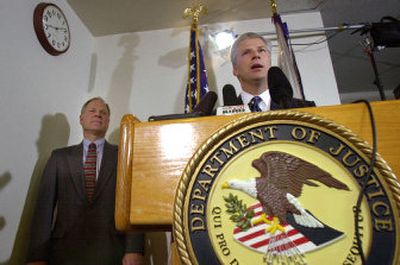Attorney praised, then sacked

SEATTLE – A month before putting John McKay on a list of U.S. attorneys to be fired, a Department of Justice official tried to help him win a federal judgeship, according to newly released documents.
“I heard that our U.S. attorney, John McKay, got screwed by Washington’s judicial selection commission,” Kyle Sampson, the former chief of staff to the attorney general, wrote to Robert Hoyt, associate counsel to President Bush, in an e-mail last Aug. 8. “What do you know? Can we let them know that we want to consider him along with the recommended candidates?”
Sampson also forwarded to Hoyt information he received from Debra Yang, then the U.S. attorney in Los Angeles, that Washington’s Democratic senators and two prominent Washington Republicans strongly supported McKay.
About a month later, on Sept. 13, McKay’s name appeared on Sampson’s list of U.S. attorneys “we should consider pushing out.” The firing of McKay and seven other U.S. attorneys last year has prompted a series of congressional hearings, questions about whether the dismissals were politically motivated and the release of thousands of pages of White House and Justice Department documents.
What happened between those dates to reverse McKay’s political fortunes remains something of a mystery, but the e-mails also show that the deputy attorney general, Paul McNulty, was upset with McKay for a letter he sent last Aug. 30. The letter, co-signed by 16 other U.S. attorneys, urged McNulty to take several steps to strengthen a law enforcement information-sharing program called LINX.
McNulty e-mailed the letter’s signers: “I am quite disappointed you have chosen to communicate with me in this way. It appears you are trying to force me to take some specific actions. It reads like a letter from Capitol Hill, not one from friends on the same team.”
But McKay said Tuesday that before sending the letter, he had a conference call with Yang and McNulty, to ensure that McNulty would welcome such a missive.
“I had a conversation beforehand,” McKay said. “I made that call with Debra Yang on the line. He agreed with everything we were doing with LINX. I thought he wanted the letter.”
In an e-mail, another Justice Department official, Mark Connor, called the letter “way out of line.”
Another internal Justice Department document – apparently talking points prepared after the controversy over the firings began – said McKay showed a “pattern of insubordination, poor judgment and demonstration of temperament issues in seeking policy changes without regard to appropriate methods or tactics.”
The same document criticized his office for sentences below the guideline range and McKay’s “extensive focus and travel outside of district to advocate policy changes, rather than proper focus on running the office.”
McKay responded Tuesday that in April 2005 he had been appointed the head of the Justice Department’s pilot program for information sharing, and that he was fully authorized to take the lead on LINX.
“When I traveled on LINX, most of the time it was at the request of other U.S. attorneys,” he said. “From everything I knew I was in great standing with the Justice Department.”
That included an overwhelmingly positive evaluation of his office by the Justice Department in spring 2006, and Sampson’s push to get McKay the judgeship in early August seems to indicate that his standing at that time was good.